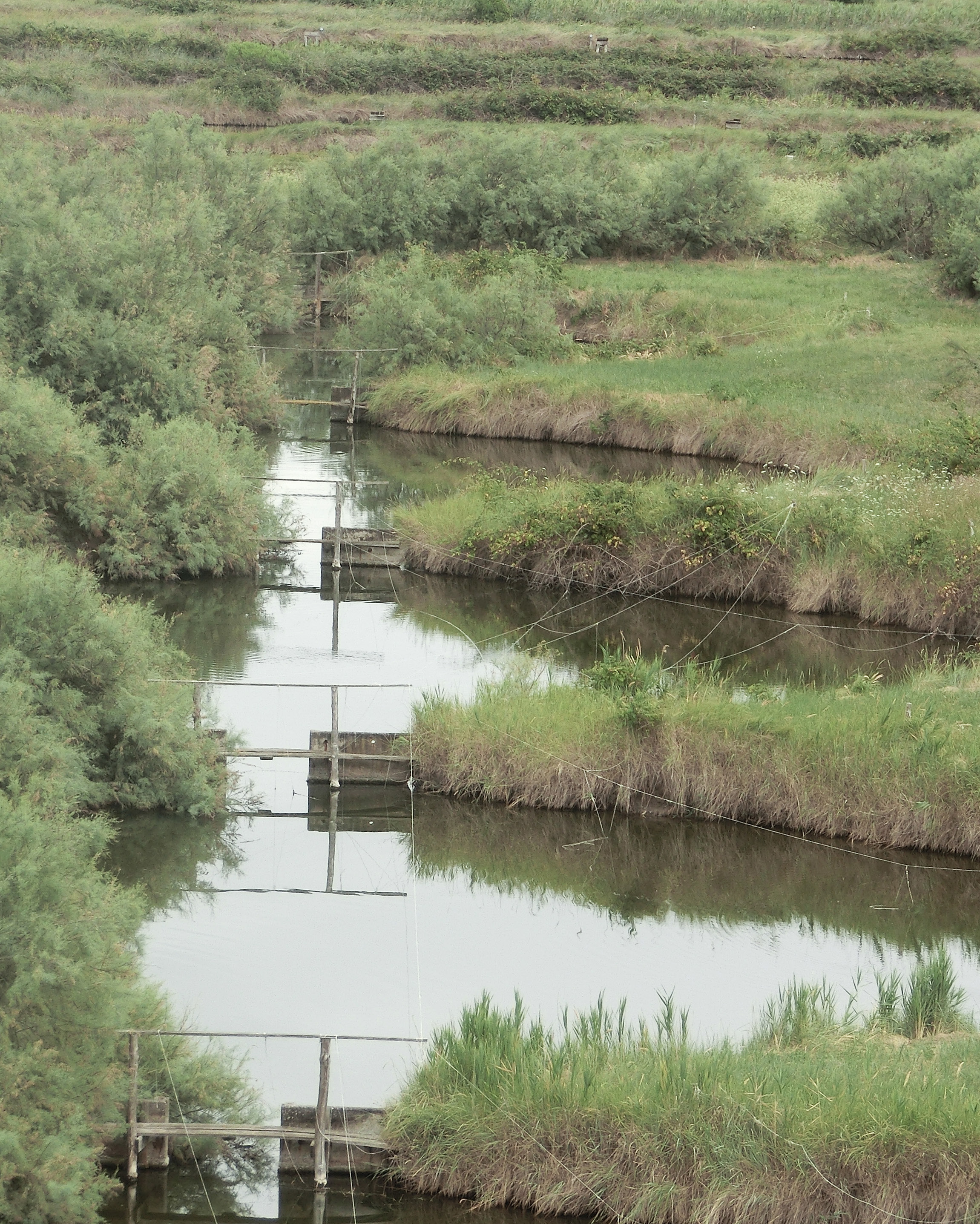

Downloads
DOI:
https://doi.org/10.58981/bluepapers.2023.2.13Published
Issue
Section
License
Copyright (c) 2023 Laura Cipriani , Alessandro Destro

This work is licensed under a Creative Commons Attribution 4.0 International License.
How to Cite
Abstract
Beginning in the fourteenth century, along the northeastern Italian coastline, Venetians began to create a series of hydraulic structures called “fishing valleys,” which combined aquaculture production with lagoon and seawater management. According to the current scenarios provided by the Intergovernmental Panel on Climate Change, the coastal areas, where many historic fish farms still stand, will inevitably be affected by the rise in sea level. To be preserved, coastlines will require some sort of water defense or possibly a managed retreat. Can we redesign traditional fish-farm systems as climate, economic and environmental adaptation devices? Through a series of design scenarios, this contribution explores how traditional fish farming can help redefine the territorial scale by addressing climate change and reviving existing production systems.
References
Alpa, Guido, Francesco Di Giovanni, Bernhard Eccher, Mario Esposito, Natalino Irti, Bernardino Libonati and Giuseppe Morbidelli. 2010. Lo Stato Giuridico delle Valli da Pesca della Laguna di Venezia [The legal status of the fish farms of the Venice Lagoon]. Padova: CEDAM.
ARPAV. 2023. Acque di Transizione. Laguna di Venezia. Monitoraggio Ecologico [Transitional waters: Venice Lagoon ecological monitoring]. https://www.arpa.veneto.it/dati-ambientali/open-data/idrosfera/acque-di-transizione/acque-di-transizione-laguna-di-venezia-monitoraggio-ecologico.
Benà, Massimo, and Giampaolo Rallo. 2011. Il Prelievo di Avifauna Acquatica nelle Zone Umide della “Zona Lagunare e Valliva” della Regione del Veneto [The sampling of aquatic avifauna in the wetlands of the “Lagoon And Valley Area” of the veneto region]. Venice: Aracne.
Cipriani, Laura. 2019. Fragile terra. Paesaggi di crisi e possibilità. 01 La bassa friulana. [Fragile earth: Landscapes of crisis and possibilities]. Venice: Università Iuav di Venezia. https://www.academia.edu/40777229/_Fr_agile_terra_Paesaggi_di_crisi_e_possibilit%C3%A0_01_La_bassa_friulana.
Cosolo, Mauro, Stefano Sponza and Umberto Fattori. 2015. “Le Valli da Pesca” [The fish-farms] In La Laguna di Marano e Grado: Un Mosaico di Biodiversità – Un Patrimonio da Preservare, edited by Regione Autonoma Friuli-Venezia Giulia, 34–7. Udine: Centro Stampa Regionale Servizio Logistica, Digitalizzazione e Servizi Generali.
D’Alpaos, Luigi. 2010. “Il Ruolo Idraulico delle Valli da Pesca” [The hydraulic role of fish farms]. In Fatti e Misfatti di Idraulica Lagunare. La Laguna di Venezia dalla Diversione dei Fiumi alle Nuove Opere delle Bocche di Porto, Luigi D’Alpaos, 165–92. Venice: Istituto Veneto di Scienze, Lettere ed Arti.
Destro, Alessandro. 2018. “Tracce di futuro lagunare. Le valli da pesca come nuova tipologia di sostegno economico” [Traces of the lagoon future: Fish farms as a new type of economic support]. Master’s thesis, Università Iuav di Venezia.
Fabris, Antonio. 1993. Valle Figheri. Storia di una Valle Salsa da Pesca della Laguna Veneta [Valle Figheri: History of a fish sauce valley in the Venetian Lagoon]. Venice: Filippi Editore.
Fortibuoni, Tomaso, Ruthy Gertwagen, Otello Giovanardi and Saša Raicevich. 2014. “The Progressive Deregulation of Fishery Management in the Venetian Lagoon after the Fall of the Repubblica Serenissima: Food for Thought on Sustainability.” Global Bioethics 25, no. 1: 42–55. https://doi-org.tudelft.idm.oclc.org/10.1080/11287462.2014.894707.
ICRAM. 2007. Quadro Generale dell’Acquacoltura Italiana [General characteristics of Italian aquaculture]. Verona: Stampa Cierre Grafica. https://www.isprambiente.gov.it/files/quadro-generale-acquacoltura.pdf.
IPCC. 2014. Climate Change 2014: Synthesis Report. Contribution of Working Groups I, II and III to the Fifth Assessment Report of the Intergovernmental Panel on Climate Change. Geneva: IPCC. https://www.ipcc.ch/report/ar5/syr/.
IPCC. 2022. Climate Change 2022: Impacts, Adaptation, and Vulnerability. Contribution of Working Group II to the Sixth Assessment Report of the Intergovernmental Panel on Climate. New York: Cambridge University Press. https://www.ipcc.ch/report/ar6/wg2/.
Neori, Amir, Thierry Chopin, Max Troell, Alejandro H. Buschmann, George P. Kraemer, Christina Halling, Muki Shpigel and Charles Yarish. 2004. “Integrated Aquaculture: Rationale, Evolution and State of the Art Emphasizing Seaweed Biofiltration in Modern Mariculture.” Aquaculture 231, no. 1–4 (March): 361–91. https://doi.org/10.1016/j.aquaculture.2003.11.015.
Nesar, Ahmed, and Marion Glaser. 2016. “Can ‘Integrated Multi-Trophic Aquaculture (IMTA)’ Adapt to Climate Change in Coastal Bangladesh?” Ocean & Coastal Management 132: 120–31. https://doi.org/10.1016/j.ocecoaman.2016.08.017.
Provincia di Venezia. 2009. Valli Veneziane. Natura, Storia e Tradizioni delle Valli da Pesca a Venezia e Caorle [Venetian Valleys. Nature, history and traditions of the fishing valleys in Venice and Caorle]. Venice: Cicero editore.
Rallo, Giampaolo. 1994. “Le Aziende Faunistico-Venatorie” [Wildlife-hunting companies]. Vallicoltura integrata 30–31: 28–49.
Rallo, Giampaolo. 1997. “The ‘Vallicoltura:’ Traditional Fish-Farming Areas in Venice Lagoon.” In Nature and Workmanship. Artificial Wetlands in the Mediterranean Coast, edited by Cipriano Marín, 81–88. Paris: UNESCO, INSULA, DGXI.
Regione del Veneto. 2020. Piano Territoriale Regionale di Coordinamento (PTRC) [Regional Territorial Coordination Plan (PTRC)]. https://www.regione.veneto.it/web/ptrc/ptrc-2020.
Regione Emilia-Romagna. 1993. Piano Territoriale Paesaggistico Regionale (PTPR) [Regional Landscape Territorial Plan (PTPR)]. https://territorio.regione.emilia-romagna.it/paesaggio/PTPR/strumenti-di-gestione-del-piano.
Regione Friuli-Venezia Giulia. 2018. Piano Paesaggistico Regionale (PPR) [Regional Landscape Plan (PPR)]. https://www.regione.fvg.it/rafvg/cms/RAFVG/ambiente-territorio/pianificazione-gestione-territorio/FOGLIA21/#id7.
Rivoal, Solene. 2021. “Enclosure within a Closed Sea? The Fisheries against the Commons in the Republic of Venice in the Eighteenth Century.” Journal for the History of Environment and Society 6: 35–60. https://doi.org/10.1484/J.JHES.5.128579.
Vatova, Aristocle. 1962. “The Salt-Water Fish Farms of the North Adriatic and their Fauna.” ICES Journal of Marine Science 27, no. 1: 109–14. https://doi-org.tudelft.idm.oclc.org/10.1093/icesjms/27.1.109.


